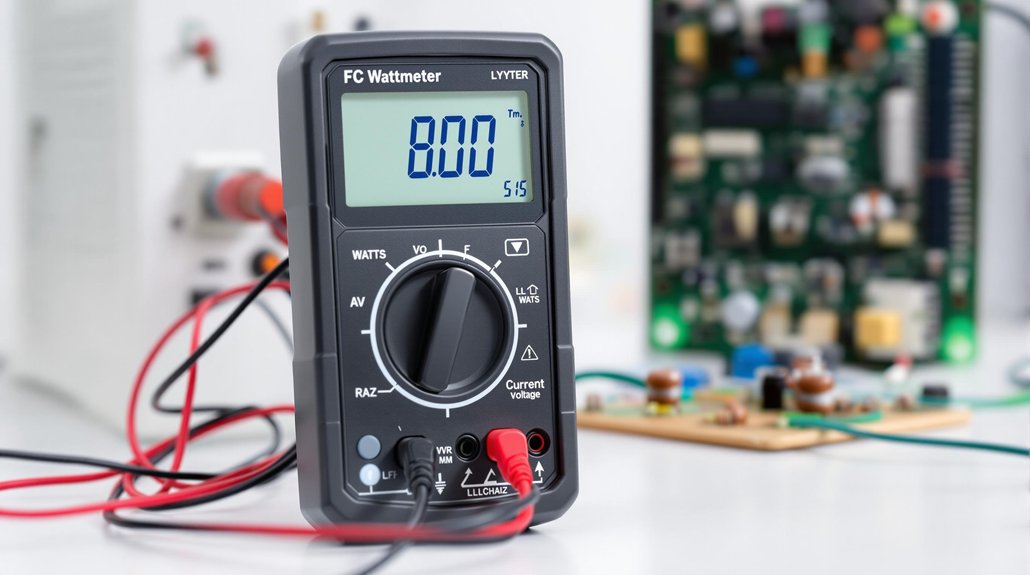Watts measure electrical power consumption and are calculated using the formula Power = Voltage × Current (P = V × I). In direct current (DC) systems, this formula is applied directly. Alternating current (AC) systems require an additional power factor component: P = V × I × cos φ. Alternative calculations include P = I² × R or P = V² / R when using Ohm’s Law. Understanding these formulas reveals the true relationship between electricity’s key components.

Every electrical device we use consumes power, measured in watts. This unit of measurement, named after scientist James Watt, tells us the rate at which energy is being transferred. Understanding how watts are calculated helps explain why some devices use more electricity than others.
Power consumption, measured in watts, reveals how quickly devices transfer energy and why some demand more electricity than others.
The basic formula for calculating watts is Power = Voltage × Current (P = V × I). Voltage represents the electrical pressure in a circuit, while current measures the flow of electricity. When these two values are multiplied, the result gives us power in watts. One watt equals one joule of energy transferred per second.
For direct current (DC) systems like batteries and solar panels, the calculation remains straightforward with P = V × I. There’s no need for additional factors since DC flows consistently in one direction. This makes DC power calculations simpler than their alternating current counterparts.
Alternating current (AC) systems, which power most homes, require an additional factor called the power factor. The formula becomes P = V × I × cos φ, where cos φ represents how efficiently power is being used. AC power has three components: apparent power (S), reactive power (Q), and real power (P), which form what’s called a power triangle.
Ohm’s Law allows for additional ways to calculate watts. If resistance (R) and current are known, P = I² × R can be used. Alternatively, with voltage and resistance, P = V² / R works equally well. This simplified approach helps determine the maximum 1,200W capacity for a 120V outlet on a 10A breaker. These variations give flexibility when certain measurements aren’t available.
Energy consumption over time is measured in watt-hours, calculated by multiplying power by time. This is what appears on electric bills, usually in kilowatt-hours (kWh). A 1000-watt device running for one hour consumes 1 kWh of energy.
Various tools help measure watts directly. Digital multimeters can measure voltage and current separately for manual calculations, while wattmeters provide direct power readings. Energy monitoring systems can track power usage throughout an entire building. Doubling the voltage while keeping resistance constant will cause power to increase by a factor of four due to the squared relationship in Joule’s Law.
Frequently Asked Questions
Can Watts Be Calculated Without Using a Multimeter?
Watts can be calculated without a multimeter through several alternative methods.
Engineers often estimate power using known device ratings or specifications printed on equipment. They can derive watts from battery capacity and runtime or use a known resistor’s specifications.
Smart plugs and energy monitoring devices offer digital readings. For motors, calculations based on speed and torque provide power estimates.
Online calculators also help determine watts when device parameters are available.
Why Do Different Appliances Consume Varying Watts of Electricity?
Appliances consume different amounts of electricity based on their functions and components.
Heating elements in toasters or ovens need high wattage (1000-5000W) to generate heat. Motors in blenders or fans use moderate power (100-1000W). Electronic devices like smartphones require minimal wattage (1-100W).
Size matters too—larger appliances typically need more power. Energy efficiency ratings also impact consumption, with newer ENERGY STAR models using 10-50% less electricity than older versions.
How Do Watts Relate to My Monthly Electricity Bill?
Watts directly impact electricity bills through a simple equation.
When appliances run, they consume watts of power. These watts, used over time, become kilowatt-hours (kWh) – the unit on monthly bills. A 100-watt bulb running for 10 hours uses 1 kWh.
Utility companies charge customers for each kWh consumed. Higher-wattage devices running frequently will greatly increase a household’s electricity costs.
Is Calculating Watts Different for AC Versus DC Circuits?
Yes, calculating watts differs between AC and DC circuits.
In DC circuits, it’s simply watts = volts × amps. The calculation is straightforward since voltage and current remain constant.
For AC circuits, it’s more complex: watts = volts × amps × power factor. This accounts for the phase differences between voltage and current.
AC calculations typically use RMS values and must consider the power factor, which isn’t needed in DC calculations.
Can Excessive Watts Damage Household Electrical Systems?
Excessive watts can indeed damage household electrical systems.
When circuits handle more power than they’re designed for, wires can overheat, causing insulation to melt. This creates fire hazards and may damage appliances.
Warning signs include frequent circuit breaker trips, flickering lights, and warm outlets.
Most homes have safety features that cut power when overloaded, but persistent issues can degrade the system over time.









